《新编剑桥商务英语》(中级)教学大纲 一、课程名称:《新编剑桥商务
- 格式:doc
- 大小:51.00 KB
- 文档页数:5

3-5《剑桥商务英语》教学大纲——理论、实训教学大纲课程编号:08005总学时数:108适用于:商务英语方向一、课程的性质、目的与任务本课程是应用英语专业的专业方向必修课。
本课程的教学目的是让英语与商务知识相结合,为毕业后成为适应社会需要的应用型涉外商务工作者打下坚实的基础。
通过学习有关商务活动的实用语言材料,学生在日常工作中能记录和传递大部分信息;能够参加日常会议或是就熟悉议题进行讨论,通过提问或问答交流客观信息;能够表达个人意见,在一定范围内参与辩论。
在阅读方面,能理解订单、投诉、约会、问询等方面的标准信函,并能向相关人员传递信息以采取进一步行动;能理解自己工作范围内的指令、程序等。
在商务写作方面,能撰写工作范围内的商务信函及报告。
教学环节以课堂讲授与商务情境模拟相结合的方式进行。
二、理论教学目的、内容与课时安排(一)企业、岗位及工作条件(建议学时数:12学时)教学目的:了解就职企业的背景、工作岗位及主要业务,培养学生的主人翁精神。
教学内容:岗位及工作条件描述、企业历史及主要业务。
教学提示重点:岗位及工作条件的描述。
难点:熟悉企业历史背景。
(二)商务交流(建议学时数:12学时)教学目的:熟悉商务秘书的主要职责,注意与客户交流中的礼仪,帮助学生树立企业的形象意识,以礼相待,客户第一。
教学内容:接听电话、商务接待及礼仪。
教学提示重点:商务接待情景模拟。
难点:商务礼仪的养成。
(三)企业的业绩、发展(建议学时数:12学时)教学目的:掌握有关企业发展趋势的描述性词汇,能有效进行业绩总结,提出可行性建议;掌握营销的3P模式,树立信心,拓宽市场。
教学内容:企业的业绩描述及3P模式的介绍。
教学提示重点:有关企业发展趋势的描述性词汇的掌握。
难点:3P模式的运用。
(四)产品生产流程及运输(建议学时数:12学时)教学目的:了解企业的设备描述,熟悉生产流程,准确介绍成品,掌握质检程序;熟悉产品运输流程。
教学内容:企业设备、产品生产及成品描述、质检及产品运输。

河北金融学院教案课程名称:剑桥商务英语教材名称:新编剑桥商务英语(中级)第三版出版单位:经济科学出版社出版时间:2008年10月主编: John Hughes教案编写人:王杰授课专业(班级):09商务英语1班授课时间:2010—2011 第一学年授课教师:王杰授课班级: 09商务英语1班授课时间:2010.9。
河北金融学院课程教案授课教师:王杰授课班级: 09商务英语1班授课时间:2010.9。
河北金融学院课程教案河北金融学院课程教案授课教师:王杰授课班级: 09商务英语1班授课时间:2010.9。
河北金融学院课程教案河北金融学院课程教案河北金融学院课程教案授课教师:王杰授课班级: 09商务英语1班授课时间:2010.10。
河北金融学院课程教案河北金融学院课程教案授课教师:王杰授课班级: 09商务英语1班授课时间:2010.10。
河北金融学院课程教案河北金融学院课程教案授课教师:王杰授课班级: 09商务英语1班授课时间:2010。
授课教师:王杰授课班级: 09商务英语1班授课时间:2010。
11。
1河北金融学院课程教案河北金融学院课程教案河北金融学院课程教案授课教师:王杰授课班级: 09商务英语1班授课时间:2010.11。
河北金融学院课程教案授课教师:王杰授课班级: 09商务英语1班授课时间:2010。
11。
22河北金融学院课程教案授课教师: 王杰授课班级: 09商务英语1班授课时间:2010.11。
25/29河北金融学院课程教案授课教师:王杰授课班级: 09商务英语1班授课时间:2010.12。
河北金融学院课程教案河北金融学院课程教案河北金融学院课程教案。
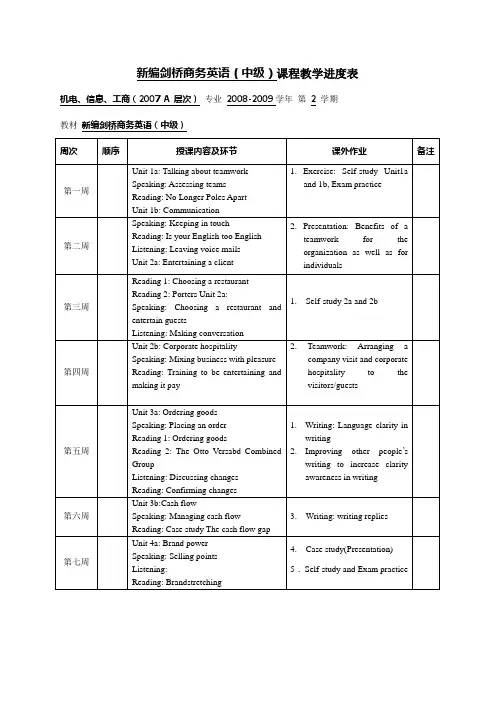
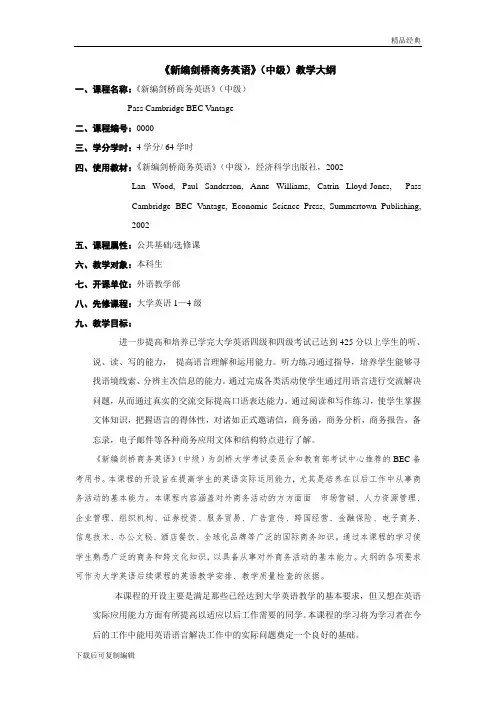
《新编剑桥商务英语》(中级)教学大纲一、课程名称:《新编剑桥商务英语》(中级)Pass Cambridge BEC V antage二、课程编号:0000三、学分学时:4学分/ 64学时四、使用教材:《新编剑桥商务英语》(中级),经济科学出版社,2002Lan Wood, Paul Sanderson, Anne Williams, Catrin Lloyd-Jones, PassCambridge BEC Vantage, Economic Science Press, Summertown Publishing,2002五、课程属性:公共基础/选修课六、教学对象:本科生七、开课单位:外语教学部八、先修课程:大学英语1—4级九、教学目标:进一步提高和培养已学完大学英语四级和四级考试已达到425分以上学生的听、说、读、写的能力,提高语言理解和运用能力。
听力练习通过指导,培养学生能够寻找语境线索、分辨主次信息的能力。
通过完成各类活动使学生通过用语言进行交流解决问题,从而通过真实的交流交际提高口语表达能力。
通过阅读和写作练习,使学生掌握文体知识,把握语言的得体性,对诸如正式邀请信,商务函,商务分析,商务报告,备忘录,电子邮件等各种商务应用文体和结构特点进行了解。
《新编剑桥商务英语》(中级)为剑桥大学考试委员会和教育部考试中心推荐的BEC备考用书。
本课程的开设旨在提高学生的英语实际运用能力,尤其是培养在以后工作中从事商务活动的基本能力。
本课程内容涵盖对外商务活动的方方面面---市场营销、人力资源管理、企业管理、组织机构、证券投资、服务贸易、广告宣传、跨国经营、金融保险、电子商务、信息技术、办公文秘、酒店餐饮、全球化品牌等广泛的国际商务知识。
通过本课程的学习使学生熟悉广泛的商务和跨文化知识,以具备从事对外商务活动的基本能力。
大纲的各项要求可作为大学英语后续课程的英语教学安排、教学质量检查的依据。
本课程的开设主要是满足那些已经达到大学英语教学的基本要求,但又想在英语实际应用能力方面有所提高以适应以后工作需要的同学。
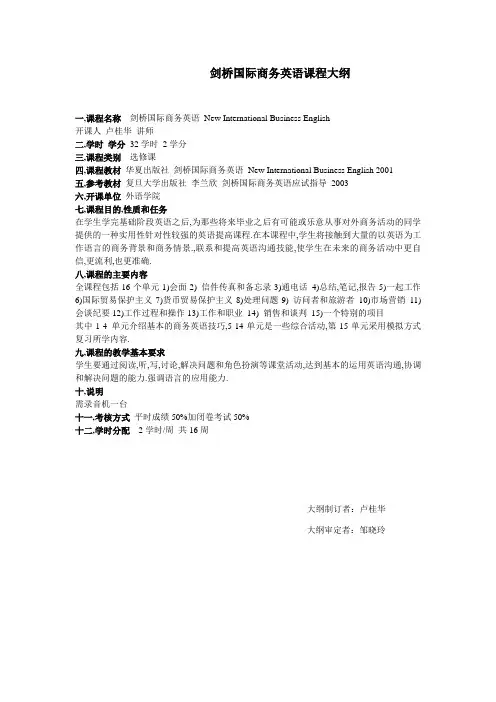
剑桥国际商务英语课程大纲一,课程名称剑桥国际商务英语New International Business English开课人卢桂华讲师二,学时学分32学时2学分三,课程类别选修课四,课程教材华夏出版社剑桥国际商务英语New International Business English 2001五,参考教材复旦大学出版社李兰欣剑桥国际商务英语应试指导2003六,开课单位外语学院七,课程目的,性质和任务在学生学完基础阶段英语之后,为那些将来毕业之后有可能或乐意从事对外商务活动的同学提供的一种实用性针对性较强的英语提高课程.在本课程中,学生将接触到大量的以英语为工作语言的商务背景和商务情景.,联系和提高英语沟通技能,使学生在未来的商务活动中更自信,更流利,也更准确.八,课程的主要内容全课程包括16个单元1)会面2) 信件传真和备忘录3)通电话4)总结,笔记,报告5)一起工作6)国际贸易保护主义7)货币贸易保护主义8)处理问题9) 访问者和旅游者10)市场营销11)会谈纪要12)工作过程和操作13)工作和职业14) 销售和谈判15)一个特别的项目其中1-4 单元介绍基本的商务英语技巧,5-14单元是一些综合活动,第15单元采用模拟方式复习所学内容.九,课程的教学基本要求学生要通过阅读,听,写,讨论,解决问题和角色扮演等课堂活动,达到基本的运用英语沟通,协调和解决问题的能力.强调语言的应用能力.十,说明需录音机一台十一,考核方式平时成绩50%加闭卷考试50%十二,学时分配2学时/周共16周大纲制订者:卢桂华大纲审定者:邹晓玲剑桥国际商务英语1 课程中文名称剑桥国际商务英语New International Business English开课人卢桂华讲师2 学时学分32学时2学分3 课程类别选修课4 预修课程大学英语5内容简介全课程包括16个单元1)会面2) 信件传真和备忘录3)通电话4)总结,笔记,报告5)一起工作6)国际贸易保护主义7)货币贸易保护主义8)处理问题9) 访问者和旅游者10)市场营销11)会谈纪要12)工作过程和操作13)工作和职业14) 销售和谈判15)一个特别的项目其中1-4 单元介绍基本的商务英语技巧,5-14单元是一些综合活动,第15单元采用模拟方式复习所学内容.学生要通过阅读,听,写,讨论,解决问题和角色扮演等课堂活动,达到基本的运用英语沟通,协调和解决问题的能力.强调语言的应用能力.6 课程教材剑桥国际商务英语New International Business English华夏出版社20017 参考书复旦大学出版社李兰欣剑桥国际商务英语应试指导20038 选课对象已通过英语四级的本科生研究生9 开课单位外语学院商务英语阅读课程教学大纲一、课程名称:《商务英语阅读》(English Readings in International Business)课程负责人:朱万忠二、学时与学分:32学时2学分三、课程类别:文化素质教育选修课四、课程教材:陈苏东,陈建平主编,《商务英语阅读》,北京:高等教育出版社,2002五、参考教材:熊伟编著, 《国际贸易实务英语》,武汉:武汉大学出版社,2001六、开课单位:重庆大学外国语学院七、课程的目的、性质和任务“商务英语阅读”使实用性很强的课程,以西方报刊中报到和论述国际商务的文章为主要内容,集英语语言学习和国际商务知识的传授为一体,通过有指导的阅读和训练,使学生掌握这类文章的文体、语言和内容特点,提高语言理解和欣赏能力,培养学生收集、整理和研究国际商务信息的能力,锻炼其逻辑思维能力,扩大其国际商务背景知识。
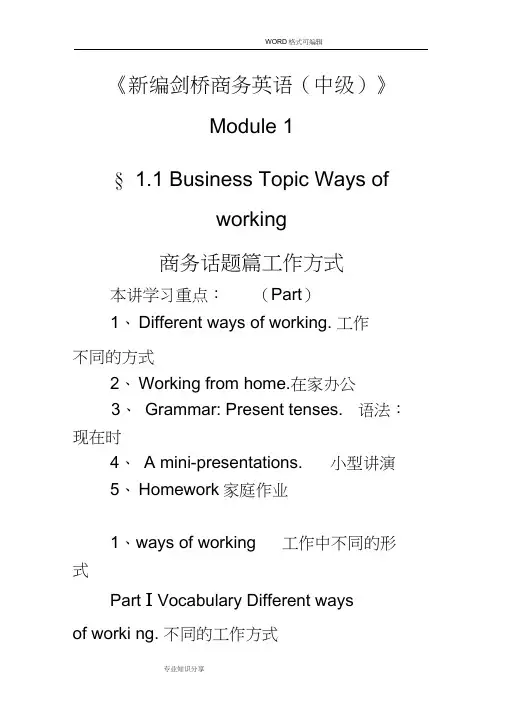
《新编剑桥商务英语(中级)》Module 1§ 1.1 Business Topic Ways ofworking商务话题篇工作方式本讲学习重点:(Part)1、Different ways of working. 工作不同的方式2、Working from home.在家办公3、Grammar: Present tenses. 语法:现在时4、A mini-presentations. 小型讲演5、Homework家庭作业1、ways of working 工作中不同的形式Part I Vocabulary Different waysof worki ng. 不同的工作方式一、Howdo work most effectively? By working ... 对你来说采用哪种工作方式最有效1、regular hours/flexible hours? 正常工作方式还是弹性工作方式固定时间/灵活时间2、in a team/on your own? 以团队为单位还是自己单干在团队中工作/自己工作3、from home/in an office? 在家还是在办公室在家上班/在办公室上班4、f or a boss/as your boss ?为别人打工还是自己当老板为别人打工/自己当老板Example:For me, I like to work flexible hours on my own. By work ing like this, I can work most effectively. Whenl need to teach my stude nts, I will go to the classroom. So I am used to flexible hours rather than working nine to five.Also, I / d like to work on my own. It is because this can allow me to be inno vative in my Ian guage teachi ngcareer.对于我来讲,我更希望自己的工作时间是弹性的。
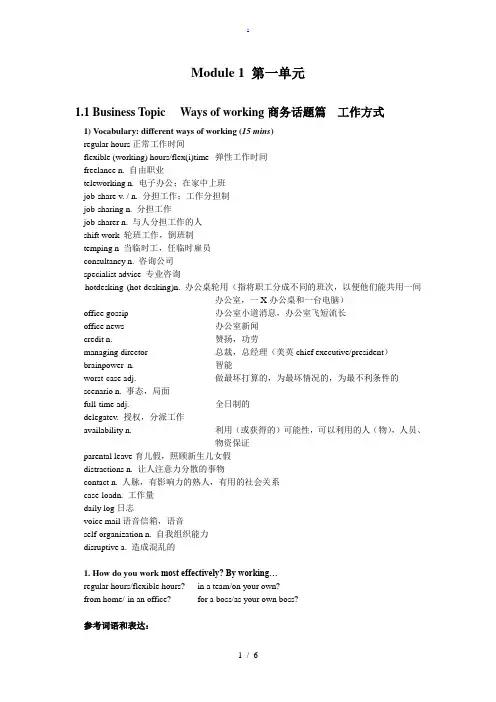
Module 1 第一单元1.1 Business Topic Ways of working 商务话题篇工作方式1) Vocabulary: different ways of working (15 mins)regular hours正常工作时间flexible (working) hours/flex(i)time 弹性工作时间freelance n. 自由职业teleworking n. 电子办公;在家中上班job-share v. / n. 分担工作;工作分担制job-sharing n. 分担工作job-sharer n. 与人分担工作的人shift work 轮班工作,倒班制temping n 当临时工,任临时雇员consultancy n. 咨询公司specialist advice 专业咨询hotdesking (hot-desking)n. 办公桌轮用(指将职工分成不同的班次,以便他们能共用一间办公室,一X办公桌和一台电脑)office gossip 办公室小道消息,办公室飞短流长office news 办公室新闻credit n. 赞扬,功劳managing director 总裁,总经理(美英chief executive/president)brainpower n. 智能worst-case adj. 做最坏打算的,为最坏情况的,为最不利条件的scenario n. 事态,局面full-time adj. 全日制的delegatev. 授权,分派工作availability n. 利用(或获得的)可能性,可以利用的人(物),人员、物资保证parental leave育儿假,照顾新生儿女假distractions n. 让人注意力分散的事物contact n. 人脉,有影响力的熟人,有用的社会关系case-loadn. 工作量daily log日志voice mail语音信箱,语音self-organization n. 自我组织能力disruptive a. 造成混乱的1. How do you work most effectively? By working…regular hours/flexible hours? in a team/on your own?from home/ in an office? for a boss/as your own boss?参考词语和表达:routine type of person按部就班的人have flexible management of time and work灵活安排自己的时间和工作get support from each other相互支持co-operate with each other相互合作share ideas交流想法learn from other people’s strong points 学他人所长working in a team needs to have good interpersonal skills and is not necessarily efficiently.在团队工作需要有很好的人际交往技能,不一定效率就高can be more concentrated and thus more efficient in an office在办公室更容易集中精力因此也更有效率have more flexibility 享有更多的灵活度feel more relaxed 感觉更轻松a dependent type of person and never make decisions myself性格依赖,不喜欢自己拿主意an independent type of person and would like to make decisions myself性格独立,喜欢自己做决定don’t want to work under someone 不想在别人手下工作5. Reading: How to job-shareGet organized Set your limits Put pen to paper Two bee one安排有序规定限度签订协议合二为一Open your mind Plan for disaster Find the perfect partner Don’t feel guilty敞开心胸/开拓视野有备无患理想搭档勿感内疚1.share credit and blame 分担成绩与过失,意译“功过与共”2. Flexecutive 经营内容蕴含其中的公司名flexible与executive两词复合而成“弹性经营管理”。
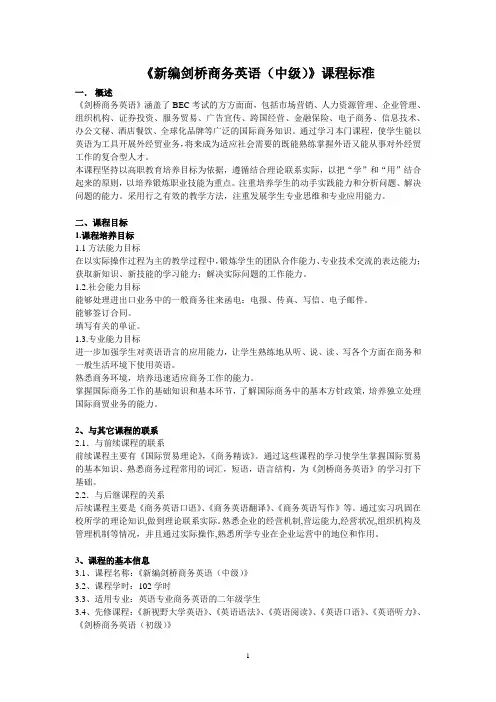
《新编剑桥商务英语(中级)》课程标准一.概述《剑桥商务英语》涵盖了BEC考试的方方面面,包括市场营销、人力资源管理、企业管理、组织机构、证券投资、服务贸易、广告宣传、跨国经营、金融保险、电子商务、信息技术、办公文秘、酒店餐饮、全球化品牌等广泛的国际商务知识。
通过学习本门课程,使学生能以英语为工具开展外经贸业务,将来成为适应社会需要的既能熟练掌握外语又能从事对外经贸工作的复合型人才。
本课程坚持以高职教育培养目标为依据,遵循结合理论联系实际,以把“学”和“用”结合起来的原则,以培养锻炼职业技能为重点。
注重培养学生的动手实践能力和分析问题、解决问题的能力。
采用行之有效的教学方法,注重发展学生专业思维和专业应用能力。
二、课程目标1.课程培养目标1.1方法能力目标在以实际操作过程为主的教学过程中,锻炼学生的团队合作能力、专业技术交流的表达能力;获取新知识、新技能的学习能力;解决实际问题的工作能力。
1.2.社会能力目标能够处理进出口业务中的一般商务往来函电:电报、传真、写信、电子邮件。
能够签订合同。
填写有关的单证。
1.3.专业能力目标进一步加强学生对英语语言的应用能力,让学生熟练地从听、说、读、写各个方面在商务和一般生活环境下使用英语。
熟悉商务环境,培养迅速适应商务工作的能力。
掌握国际商务工作的基础知识和基本环节,了解国际商务中的基本方针政策,培养独立处理国际商贸业务的能力。
2、与其它课程的联系2.1.与前续课程的联系前续课程主要有《国际贸易理论》,《商务精读》。
通过这些课程的学习使学生掌握国际贸易的基本知识、熟悉商务过程常用的词汇,短语,语言结构,为《剑桥商务英语》的学习打下基础。
2.2.与后继课程的关系后续课程主要是《商务英语口语》、《商务英语翻译》、《商务英语写作》等。
通过实习巩固在校所学的理论知识,做到理论联系实际。
熟悉企业的经营机制,营运能力,经营状况,组织机构及管理机制等情况,并且通过实际操作,熟悉所学专业在企业运营中的地位和作用。
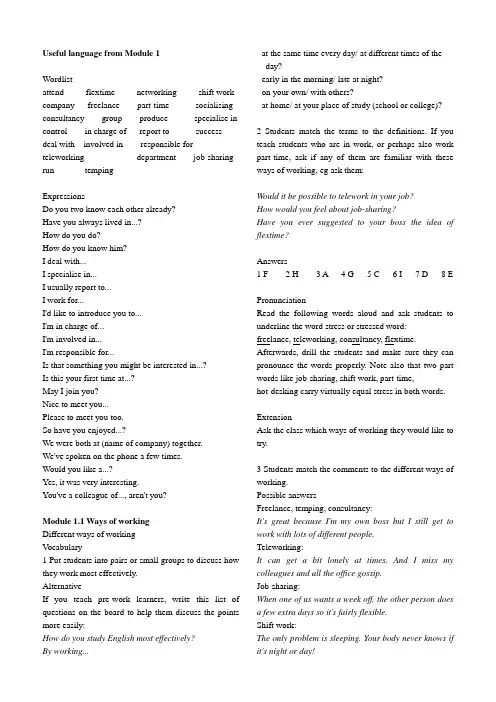
Useful language from Module 1Wordlistattend flextime networking shift work company freelance part-time socialising consultancy group produce specialise in control in charge of report to success deal with involved in responsible for teleworking department job-sharing run tempingExpressionsDo you two know each other already?Have you always lived in...?How do you do?How do you know him?I deal with...I specialise in...I usually report to...I work for...I'd like to introduce you to...I'm in charge of...I'm involved in...I'm responsible for...Is that something you might be interested in...?Is this your first time at...?May I join you?Nice to meet you...Please to meet you too.So have you enjoyed...?We were both at (name of company) together.We've spoken on the phone a few times.Would you like a...?Yes, it was very interesting.You've a colleague of..., aren't you?Module 1.1 Ways of workingDifferent ways of workingV ocabulary1 Put students into pairs or small groups to discuss how they work most effectively.AlternativeIf you teach pre-work learners, write this list of questions on the board to help them discuss the points more easily:How do you study English most effectively?By working... - at the same time every day/ at different times of the day?- early in the morning/ late at night?- on your own/ with others?- at home/ at your place of study (school or college)?2 Students match the terms to the definitions. If you teach students who are in work, or perhaps also work part-time, ask if any of them are familiar with these ways of working, eg ask them:Would it be possible to telework in your job?How would you feel about job-sharing?Have you ever suggested to your boss the idea of flextime?Answers1 F2 H3 A4 G5 C6 I7 D8 EPronunciationRead the following words aloud and ask students to underline the word stress or stressed word: freelance, teleworking, consultancy, flextime. Afterwards, drill the students and make sure they can pronounce the words properly. Note also that two-part words like job-sharing, shift work, part-time,hot-desking carry virtually equal stress in both words.ExtensionAsk the class which ways of working they would like to try.3 Students match the comments to the different ways of working.Possible answersFreelance, temping, consultancy:It's great because I'm my own boss but I still get to work with lots of different people.Teleworking:It can get a bit lonely at times. And I miss my colleagues and all the office gossip.Job-sharing:When one of us wants a week off, the other person does a few extra days so it's fairly flexible.Shift work:The only problem is sleeping. Your body never knows if it's night or day!Part-time, teleworking:My children are at school so it lets me spend more time with them.Temping:I like it because it's only for a couple of months and I'm saving my money to go round the world.Hot-desking:I wish I had my own space. I have to carry everything around in my bag and sometimes there's nowhere to sit.4 Put students into groups to discuss more advantages and disadvantages. If time is short, give each group one way of working. Collate their ideas on the board in a table as shown below.Possible answersPossible Possibleadvantages disadvantages freelance you choose the job no job security teleworking organise your work you need to be good time at self-organisation job-sharing more free time need to coordinatewith other person shift work gives you your days tiringfreepart-time more free time less money temping lots of variety hard to progressyour career consultancy well paid no job security flexitime good for work-life not good for peoplebalance who like routine hot-desking saves the company disruptive tomoney employeesHow to job-shareReading5 Ask students to read the whole text before they put the headings with the correct paragraphs. Tell them that they won't need to understand every word to complete this reading task.Answers1 Open your mind2 Plan for disaster3 Get organised4 Set your limits5 Put pen to paper6 Don't feel guilty7 Two become one 6 Students can discuss these two questions as a class. Refer them to the Exam Success tip about question 6.Extension 1Put students into pairs. Student A is the employee and Student B is the employer. Tell them to imagine Student A wants to start job-sharing with another colleague. They must try to convince their employer that it is a good idea and mention the advantages. Student B should be skeptical and mention disadvantages. Set a time limit of three minutes for each conversation. Then students change partners and swap roles.Extension 2After reading the Exam Success tip, ask students to think of possible questions in pairs and then write everyone's ideas on the board. Finally, you can ask students to work in pairs. One student pretends to be an examiner and ask some of the questions. The other student tries to answer them. At this early stage of the course, focus on the positive aspects of their responses in your feedback. The main aim is for students to be introduced to the idea that they will have to be able to talk on many different areas of business in the exam.Working from homeListening1) 1.1 You may need to play the recording twice for students to listen and take notes.Answers1 Have a timetable and stick to it.2 Advantages:- you spend more time with the children- more flexibility- the company saves money on office space- no commutingDisadvantages:- sometimes you work in the evening- you miss people and office news.1.1 Listening scriptI=Interviewer M=MichelaI OK, Michela. You work from home now. Can you tell me about a typical day?M Sure, I always get up around seven and the first thing I do is get the kids ready for school. I take them at eight thirty and then I always start work at nine.I Do you ever have a day where you decide to have the morning off and start work later?M No, you can't do that. It's important with home-working to have a timetable and stick to it. If you end up watching TV or doing the cleaning then it isn't for you. So I have lunch at twelve and finish work at two thirty to get the children.I Was that why you gave up your office job?M Yes, I wanted to spend more time with the children. It gives me more flexibility. Sometimes I need to work in the evening but usually it isn't a problem.I So how long have you been doing this kind of work? M For about five years. I've been with the same company since I left school, but with the Internet and technology it's easy now to be at home.I So your employer doesn't mind.M No. It means the company saves money on office space and as long as I get the work done, they're happy. Sometimes I still go into work to meet clients and so on. For example, I'm going in nearly every day this week because we have visitors from another company and I can't really invite them over to my house. Besides, it's nice to go in every so often. I like to see people and catch up on the gossip and the news with my colleagues.I miss that side of going into work every day.I Is there anything else you miss?M Ermm. No, not really. And I'll tell you what I really don't miss and that's having to spend two hours commuting on the bus and train every day...2) 1.1 Play the record again. Students complete the notes.Answers1 7:00 - get up, get the kids ready8:30 - take kids to school9:00 - start work12:00 - have lunch14:30 - finish work2 She's been with her current employer since she left school, but she's been home-working for five years.3 She's going to the office every day to meet visitors.Present tensesGrammar3) Students match the sentences to the explanations. Tell them that the sentences come from the listening. Answers1 B2 D3 A4 C4) Students name the tenses in exercise 3.Answers1 Present simple2 Present perfect continuous3 Present perfect simple4 Present continuousPhotocopiable activity 1.1See page 1605) Refer students to the Grammar Tip and clarify that state verbs are usually in the simple form. As students write the verb forms in the text, refer them to page 128 in the Grammar Reference at the back of the Student's Book.Answers1 need2 communicate3 have escaped4 have been working5 have been6 'm working7 answerA mini-presentationSpeakingRefer students to the Exam Success tip. Make sure students realise that the task is similar to Part Two of the Speaking Test. This exercise gives students the opportunity to bring together many of the ideas and vocabulary looked at in the module so far. Working in pairs, each student prepares a mini-presentation based on A or B. Refer students to the previous reading and listening from this module to help them prepare ideas. Then students give their presentation to each other. Note that in the exam the length of these presentations is about one minute so you could set this as a time limit. Make notes on any problems with vocabulary and give feedback.You could ask any students giving especially good presentations to present to the class. This will help to model what is required for the exam.Module 1.2 Making ContactsJob responsibilitiesVocabulary1 Ask students to underline the correct preposition before they start speaking in pairs.Answerswork forresponsible forreport tospecialise ininvolved indeal within charge ofAlternativeFor pre-work or unemployed students, make copies of the business cards on page 161 and give one to each student. They imagine they have the job on the card and make sentences with the expressions.2 This exercise encourages students to use the third person form of the verbs in exercise 1.AlternativePre-work learners can describe people or friends they see at their place of study.3 Students with work experience can tell the rest of the class their response to this question. If no students formally "network" in your class, ask students why they think networking is important.Possible answer"Networking" is the skill of making contacts and can help people progress in their career through knowing the "right" people. The skill is important in areas such as sales where you need to develop relationship with potential customers.Life's all about making connectionsReadingStudents read and choose the best answer. Ask them to compare their answers with a partner.Answers1 A2 A3 C4 C5 B6 A7 B8 C9 A 10 C5 Ask students to underline the parts of the text which tell you where people network and the reasons why. Then ask students to give their answers and discuss the second question as a class. AnswerPeople network at:- conferences- trade fair events- coffee breaks- formal "networking" eventsThe reasons are:- to help people maximize their potential- to get to know other people- for people with little experienceStarting a conversationListening6 1.2 Students listen and match the conversations to the locations.Answers1 C2 A3 D4 B1.2 Listening scriptConversation 1R=Richard W=Woman M=MarekR Hello?W Hello, Richard. I'd like to introduce you to Marek.R Oh, yes. Hello, Marek. How do you do? Nice to meet you at last.M Hello, Richard. Pleased to meet you too.W Oh, do you two know each other already?M Well, we've spoken on the phone a few times.R But we've never actually met. Anyway, take a seat. Would you both like a coffee?Conversation 2A Would you like a coffee?B Oh thanks.A Milk?B Yes, it was very interesting. The first speaker was particularly good.A Is this your first time at one of these events?B Yes, it is. And you?A No. I've been coming for years. The company pays and if the location is good then I come. I remember the best year we had was in Monaco...Conversation 3M=Marie W=WomanM May I join you?W Sure.M You're a colleague of Martin Obach, aren't you?W That's right. He works in our Barcelona office. How do you know him?M We were both at Elcotil together. He left about a year before me.W Oh, are you Mandy?M Marie.W Marie. That's right. Sorry, I knew it began with an M. Yes, Martin said you were doing this course and that I should say hello...Conversation 4A Well, this is nice.B Well, it's quite simple but the food is very traditional and it's popular with the locals. On Sundays I often bring the family here.A That's nice. How many children do you have?B Two. Twins. A boy and a girl. They've just started school.A Wow. Twins.B And you?A No, not yet. And have you always lived in Lille?B Yes, most of my life. I worked in Paris for a while and in your country, of course. But all my relatives are here. What about your family?A Oh, they're spread out. I see my parents from time to time but my sister lives in Norway with her husband so we don't get together much. Anyway, I know your company is looking for a partner on this Thai project.B Yes. Is that something you might be interested in...7/8 1.2 Students match the expressions to the responses and then check by listening. If they find the first stage difficult, they can do the matching task while they listen to the recording.Answers1 D2 I3 C4 J5 A6 E7 K 8 L 9 F 10 G 11 H9 Students practice the expressions and reponses in a controlled way. Note that the student with the book closed doesn't have to give exactly the same response as those in the book. Write any good examples of responses generated by students on the board after- wards to share with the rest of the class. 10 Typically students will suggest topics like weather, travel, countries, work and language. However, note that with some cultures, topics such as politics, religion or family may not be appropriate. If you have a class with students from many different cultures or experience of travel, open this up for discussion and draw on students' experiences of dealing with different cultures.Developing a conversationSpeaking11 Before you begin, give students time to study the flowchart. Elicit from them the type of expressions they might use at each stage of the flowchart. If possible, clear space in the classroom for students to walk around and simulate networking with each other. If there isn't space, students could work in pairs and follow the flowchart.Photocopiable activity 1.2See page 161.Business correspondenceWritingThis first writing section provides a general overview of different correspondence and will help students with Part One of the Writing Test in particular.1 Give students a time limit of 10 minutes to answer the questions.Answers1) The email and post-it note are not related to her work.2) The memo and the letter are formal because they are giving information and replying to a customer with a complaint. The language uses quite long and fixed expressions.3) The memo is "internal communication" because it was sent within the company. Everyone in the company received a copy of it.4) The memo uses the T0/From/Date/Subject headings. It doesn't require an opening salutation line (Dear...) or closing salutation (Best...Yours...). Memos often have only one paragraph.5) Tel./asap/@/RE2 Refer students to the Exam Success tip. Ask them to complete the table using words from the correspondence in exercise 1. The table will givestudents a very useful reference for further writing during their course.Answers1) I am writing to...2/3) Further to our previous meeting/ With regard to your letter dated...4) how about5) I would like to apologise for6) I'm sorry that...7) we are pleased to8) Unfortunately9) Can you10) Do you want me to11) May I remind you...12) Don't forget13) we look forward to working with you...14) See you soon15) Yours sincerely3 Tell students that this exercise is typical of a question from the Writing Test. If they do the task in class, you could put them into pairs to write it together.Note that the memos must be very succinct to have only 40-50 words and that the To/From/Date/Subject heading is not included in the word count. Typically, students will find it hard to keep within this word count and make their ideas short and simple. Students will find it helpful to use the memo on page 12 as a model.Possible answerTo: All StaffFrom: (Name of student)Date: 25th JulySubject: Parental LeaveFurther to our previous meeting, I am pleased to confirm that parental leave for fathers has been extended to three weeks. The new system will come into operation as from 25th September. May I remind you that your managers will require one month's notice?Module 1.3 Speaking Test: Part OneExam FormatRead the opening description of this part of the exam with the students. Refer students to the Exam Success tip. Exam Practice1 This exercise looks at some typical mistakes that students make in the first part of the exam.AnswersA Yes, I think English...B ...I'm interested in marketing.C I'm from...D I'd like to work...E Actually, I'm just finishing my degree...F For about six years.2 Students complete the conversation with corrected answers O-F.Answers1 O2 C3 E4 B5 D6 A7 F3 To set this up, the student playing the part of candidate can close their book and answer the examiner's questions in exercise 2 in their own words. Refer students to the Learning Tip which suggests that students record and self-evaluate their performance. If possible, record them in the classroom and let them listen and note any common errors.4 In the opening part of the Speaking Test, the examiner can also ask general questions about business topics. Refer students to the Exam Success tip. Note that these questions don't rely on specialist knowledge and pre-work students should be able to respond as well as in-work students. Let students read the topics and briefly discuss with the class how difficult they would find these to give a short comment on. If any students look concerned about the topics, point out that the Student's Book covers all of these (and more) both in terms of content and language.5 1.3 Play the extract from the speaking test. Answers / The examiner asks about:- business in your home town or country.- present and future changes in working life.1.3 Listening scriptE=Examiner C=CandidateE And where do you live exactly?C I'm from a small town in northern Switzerland, but at the moment I'm studying for a business degree so I live in Zurich.E What types of business are most successful in your town?C Er, well, I suppose that tourism is quite important to the area and there are many small farms of agriculture also. Zurich, where I study, is more famous of course for banking and financial services.E How is working life changing in your country?C Sorry, can you repeat the question, please?E Yes, how is working life changing in your country?C I think that more and more people are moving to the cities or they are commuting in every day. In my opinion, the biggest change has come from technology - but then that's probably true everywhere, not just in my country...6 1.3 Students listen again and complete the gaps with phrases which will be useful for the speaking test. Answers1 I suppose that2 can you repeat3 I think that...4 In my opinion7 In pairs, students prepare questions they think an examiner might ask on the topics in exercise 4. Students take their questions and work with another partner. Each student takes turns to ask and answer the questions.Possible questions1) What kind of business is very important in your home town?2) Do you think English will continue to be important for business in the future?3) Which technology has had the biggest effect on business in recent years?4) In what ways do you think working life will change in the next ten years?5) If you had a choice of working training, what would it be? Why?6) How effective is selling over the phone?Exam Self-check8 Students can grade themselves in exercise 7 using the Exam self-check. An alternative is to put the students into groups of three so that one student is listening to the interview and marking the candidate with the Exam self-check. Students then change roles so that the interview is repeated three times. ExtensionNow that students have practised the first part of the Speaking Test both with personal information questions (in exercise 3) and further business related questions (in exercise 7), they can repeat all of Part One of the Speaking Test, both as examiner and candidate. They will find it helpful to refer to the Useful expressions summary at the bottom of page 15 and, again, they can use the Exam self-check in exercise 8 to evaluate their performances.。
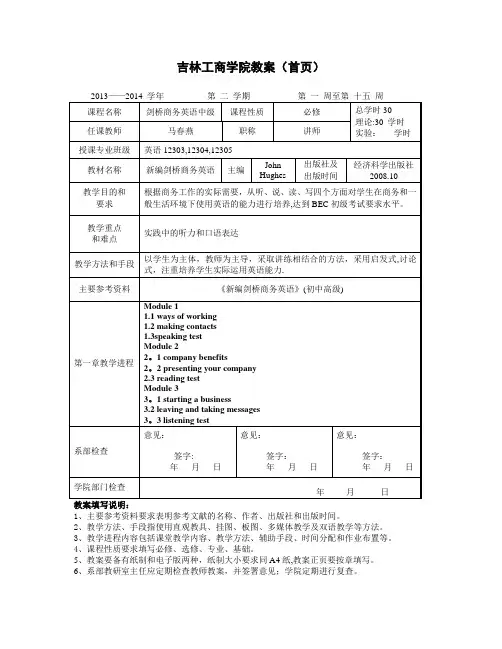
吉林工商学院教案(首页)1、主要参考资料要求表明参考文献的名称、作者、出版社和出版时间。
2、教学方法、手段指使用直观教具、挂图、板图、多媒体教学及双语教学等方法。
3、教学进程内容包括课堂教学内容、教学方法、辅助手段、时间分配和作业布置等。
4、课程性质要求填写必修、选修、专业、基础。
5、教案要备有纸制和电子版两种,纸制大小要求同A4纸,教案正页要按章填写。
6、系部教研室主任应定期检查教师教案,并签署意见;学院定期进行复查。
教案(正页)课程名称: bec 中级辅导学时:2 第次课上课日期:Teaching aims:1. To enable Ss to know the basic information about BEC vantage exam and talk about teamwork2。
To learn some ways to understand and build vocabulary3. To talk about teamwork4. To learn how to understand and build vocabulary5.To learn expressions on making and changing arrangementDifficult points:To learn how to understand and build vocabularyTo practice making and changing arrangementsTeaching methods:Discussion and oral presentation1。
1 ways of workingWarm—upSpeakingStep1 choose the five most important characteristics of a good team and put them in orderStep2 pair work。
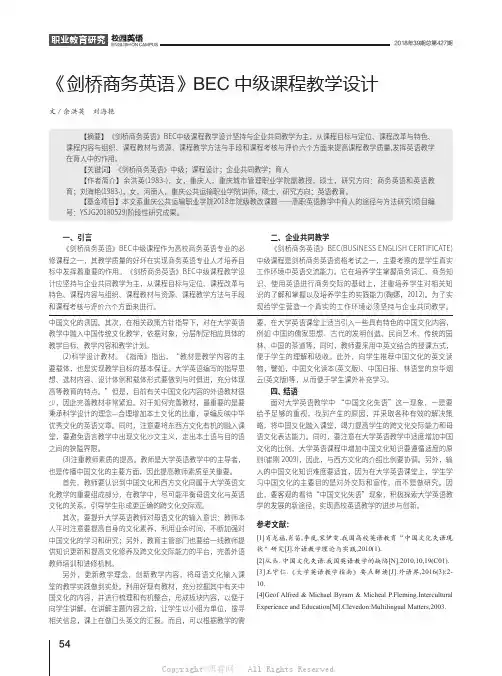
542018年39期总第427期ENGLISH ON CAMPUS教学中融入中国传统文化教学,依据对象,分层制定相应具体的教学目标、教学内容和教学计划。
(2)科学设计教材。
《指南》指出,“教材是教学内容的主要载体,也是实现教学目标的基本保证。
大学英语编写的指导思想、选材内容、设计体例和载体形式要做到与时俱进,充分体现高等教育的特点。
”但是,目前有关中国文化内容的外语教材很少,因此完善教材非常紧迫。
对于如何完善教材,最重要的是要秉承科学设计的理念—合理增加本土文化的比重,录编反映中华优秀文化的英语文章。
同时,注意要将东西方文化有机的融入课堂,要避免语言教学中出现文化沙文主义,走出本土语与目的语之间的狭隘界限。
(3)注重教师素质的提高。
教师是大学英语教学中的主导者,也是传播中国文化的主要方面,因此提高教师素质至关重要。
首先,教师要认识到中国文化和西方文化同属于大学英语文化教学的重要组成部分,在教学中,尽可能平衡母语文化与英语文化的关系,引导学生形成更正确的跨文化交际观。
其次,要提升大学英语教师对母语文化的输入意识:教师本人平时注意要提高自身的文化素养,利用业余时间,不断加强对中国文化的学习和研究;另外,教育主管部门也要给一线教师提供知识更新和提高文化修养及跨文化交际能力的平台,完善外语教师培训和进修机制。
另外,更新教学理念,创新教学内容,将母语文化输入课堂的教学实践做到实处。
利用好现有教材,充分挖掘其中有关中国文化的内容,并进行梳理和有机整合,形成板块内容,以便于向学生讲解。
在讲解主题内容之前,让学生以小组为单位,搜寻相关信息,课上在做口头英文的汇报。
而且,可以根据教学的需例如 中国的儒家思想、古代的发明创造、民间艺术、传统的园林、中国的茶道等,同时,教师要采用中英文结合的授课方式,便于学生的理解和吸收。
此外,向学生推荐中国文化的英文读物,譬如,中国文化读本(英文版)、中国日报、林语堂的京华烟云(英文版)等,从而便于学生课外补充学习。
《剑桥商务英语(中级)》课程教学大纲
一、课程信息
通过本课程的学习,学生应具备以下儿方面的目标:
1.了解英语国家企业工作方式、公司利润、开拓业务、广告营销、工作场所、人才招聘、产品销售、职业发展、品牌推广、企业管理、商业道德和商业法律的知识。
2.在不同语境中,选择合适的文体,遵循商务习惯和国际惯例,使用恰当准确的语言进行商务交流。
3.掌握重要的应试技巧,通过剑桥商务英语证书考试。
4.掌握在真实工作环境中使用商务英语交流的能力。
5.树立正确的价值观,具有从事商务英语交流的愿望和兴趣,形成遵纪守法、诚信经营、锐意进取的理念。
课程目标对毕业要求的支撑关系表
三、教学内容与预期学习成效
四、成绩评定及考核方式
五、课程建议教材及主要参考资料
1.建议教材
John Hughes.《新编剑桥商务英语(中级)学生用书》(第三版).北京:经济科学出版社,2010.7
2.主要参考资料
1)John Hughes.《新编剑桥商务英语(中级)教师用书》(第三版).北京:经济科学出版社,2010.7.
2)剑桥大学外语考试部.《新版剑桥商务英语BEC中级真题集》.北京:商务印书馆, 2015.9
3)Ian Wood.《直通剑桥商务英语》.北京:清华大学出版社,2018.05。
《剑桥国际商务英语》课程教学大纲课程总学时:108 理论学时:62 执笔人:孟令超适用于三年制高职高专商务英语、应用英语、国际贸易等专业一、课程的性质、任务和要求《剑桥国际商务英语》课程一门专业基础核心课。
本课程教学时数共108学时,其中理论教学62学时,实训教学46学时。
考试课。
课程适用于高职高专商务英语、应用英语、国际贸易等专业一年级上学期和下学期。
《剑桥国际商务英语》课程的主要任务是:使学生通过本大纲所规定的全部教学内容的学习,掌握国际商务英语的基本沟通技能,达到全面提升学生在商务和一般生活环境下综合运用英语进行交际的能力的目的。
因此,通过本课程的学习,学生应达到下列要求:1.了解一般商务知识、常用商务英语文件格式及写作方法(广告、通知、图表、产品介绍、报刊文单元等)。
2.掌握与一般生活、商务活动及日常业务相关的功能性语言及语言技巧的运用。
3.熟练掌握英语听、说、读、写等综合语言技能,培养学生的国际商务沟通能力,信息获取、整合及应用能力。
二、课程教学内容绪论课程介绍1.使学生了解和熟悉剑桥商务英语证书教程的总体教学内容2.向学生介绍该课程的学习方法第一单元工作描述与工作环境1.主要内容:谈论工作、职责和工作环境的功能性语言;正确运用一般现在时、频率等进行表达;相关的听说读写能力2.重点:谈论工作、职责和工作环境的功能性语言3.难点:相关的听说读写能力4.教学要求:要求学生能够用正确的语法形式和功能性语言熟练谈论工作和职责和工作环境。
5.习题要求:相关的口语与听力训练;课后书面练习内容第二单元公司历史与公司活动1.主要内容: 谈论公司的发展历史、组织结构和公司活动的语言技巧和功能性语言点;正确运用一般过去时、现在进行时和表示时间的介词用法、表示附加与对比的语言技巧。
2.重点:谈论公司的发展历史、组织结构和公司活动的语言技巧和功能性语言点。
3.难点:相关的阅读理解能力4.教学要求:要求学生能够熟练运用功能性语言点谈论公司的发展历史、组织结构和公司活动;通过阅读了解公司运行和发展情况5.习题要求:随堂案例讨论;课后书面练习第三单元商务英语词汇的学习与应试技巧1.主要内容:商务英语词汇的学习与应试技巧2.重点:扩充商务英语词汇的策略3.难点:商务英语词汇的记忆储存技巧4.教学要求:使学生了解并掌握商务英语词汇学习的基本方法5.习题要求:示例训练;课后练习第四单元电话与公司内部沟通技巧1.主要内容:进行电话沟通的技巧与功能性语言、做电话记录的技巧、进行内部沟通不同的书面文本形式与语言特点2.重点:电话沟通的技巧与功能性语言3.难点:做电话记录的技巧、进行内部沟通的方式与语言特点;相关的听说读写技能4.教学要求:使学生掌握电话沟通的技巧,能够运用电话沟通的功能性语言进行交流、记录;运用正确的书面文体进行公司内部沟通。
《新编剑桥商务英语》(中级)教学大纲
一、课程名称:《新编剑桥商务英语》(中级)
Pass Cambridge BEC V antage
二、课程编号:0000
三、学分学时:4学分/ 64学时
四、使用教材:《新编剑桥商务英语》(中级),经济科学出版社,2002
Lan Wood, Paul Sanderson, Anne Williams, Catrin Lloyd-Jones, Pass
Cambridge BEC Vantage, Economic Science Press, Summertown Publishing,
2002
五、课程属性:公共基础/选修课
六、教学对象:本科生
七、开课单位:外语教学部
八、先修课程:大学英语1—4级
九、教学目标:
进一步提高和培养已学完大学英语四级和四级考试已达到425分以上学生的听、说、读、写的能力,提高语言理解和运用能力。
听力练习通过指导,培养学生能够寻找语境线索、分辨主次信息的能力。
通过完成各类活动使学生通过用语言进行交流解决问题,从而通过真实的交流交际提高口语表达能力。
通过阅读和写作练习,使学生掌握文体知识,把握语言的得体性,对诸如正式邀请信,商务函,商务分析,商务报告,备忘录,电子邮件等各种商务应用文体和结构特点进行了解。
《新编剑桥商务英语》(中级)为剑桥大学考试委员会和教育部考试中心推荐的BEC备考用书。
本课程的开设旨在提高学生的英语实际运用能力,尤其是培养在以后工作中从事商务活动的基本能力。
本课程内容涵盖对外商务活动的方方面面---市场营销、人力资源管理、企业管理、组织机构、证券投资、服务贸易、广告宣传、跨国经营、金融保险、电子商务、信息技术、办公文秘、酒店餐饮、全球化品牌等广泛的国际商务知识。
通过本课程的学习使学生熟悉广泛的商务和跨文化知识,以具备从事对外商务活动的基本能力。
大纲的各项要求可作为大学英语后续课程的英语教学安排、教学质量检查的依据。
本课程的开设主要是满足那些已经达到大学英语教学的基本要求,但又想在英语实际应用能力方面有所提高以适应以后工作需要的同学。
本课程的学习将为学习者在今后的工作中能用英语语言解决工作中的实际问题奠定一个良好的基础。
十、课程要求:
本课程的教学内容主要包括听、说、读、写四个方面。
教学活动要突出学生在课堂中的中心位置,以提高学生的英语实际运用能力,尤其是培养在以后工作中从事商务活动的基本能力。
通过完成各项任务达到提高语言交流能力的目的通过本课程的学习,学生能够通过语言解决生活和工作中的问题,达到交流的目的,并具备从事对外商务活动的基本能力和基本的国际间的交往能力。
十一、教学内容:
本课程由十个单元内容组成,每单元分两个话题:
第一单元:Unit 1a Teamwork团队合作,Unit 1b Communication交流(Unit1a 4学时,Unit1b 3学时)
⏹知识要点:1. 学会在讨论优秀团队所具备的特点时所用的词汇、表达法等
2. 学会记录电话信息和给对方留电话信息
⏹重点难点:阅读和听力过程中语篇宏观信息和具体信息的掌握
⏹教学方法:讲解\讨论课后作业
第二单元Unit 2a Entertaining a Client 招待客户Unit 2b Corporate Hospitality商务接待
( Unit 2a 3学时, Unit 2b 5学时)
⏹知识要点: 1. 学习在对外交往中的礼仪,以及在对话时鼓励对方谈话的各种表达方
式
2. 学会讨论商务接待这一话题
3.分辨商务信函的正式和非正式文体
4. 掌握有关邀请及接受邀请方面的常用语
5. 学会写接受邀请的信件
⏹重点难点:应付话题的方法,在阅读和听力过程中寻找语篇大意及具体信息
⏹教学方法:讲解\讨论案例教学和具体模拟实践, 课后作业
第三单元: Unit3a Ordering Goods 订货Unit3b Cash Flow 现金流量(Unit 3a 3学时, Unit 3b学时)
⏹知识要点:1. 学会讨论订单和更改订单这一话题
2. 学会写作时如何做到文意清晰,并掌握信函中常用句型
3. 学会写简短的商务传真函件
4. 学会校读写好的商务函件
5. 学会谈论公司日常财务话题
6. 学会写商务便条
⏹重点难点:听力过程中的细节的理解
⏹教学方法:讲解\讨论案例教学, 课后作业
第四单元: Unit4a Brand Power 品牌力量Unit4b Public Relations 公共关系(Unit4a 3学时, Unit4b 3学时
⏹知识要点:1. 学会谈论品牌和营销这一话题
2. 学会阅读时获取语篇的具体信息,理解细节
3. 学会谈论公共关系话题
4. 学会对工作职责进行描述
⏹重点难点:听力过程中获取主要信息和具体信息
⏹教学方法:讲解\讨论案例教学, 课后作业
第五单元: Unit 5a Relocation 迁址安置Unit 5b New Premises 新的场所(Unit 5a 4学时, Unit 5b 3学时)
⏹知识要点:1. 学会谈论迁址安置这一话题
2. 学会阅读时获取语篇的主要信息
3. 掌握商务报告的写作特点并学会写商务报告
4. 学会表达事物的相同点和差异点
5. 学会谈论办公场所以及办公设施话题
6. 学会听懂别人指路时的各种表达并学会给别人指路
7. 学会写商务信件
⏹重点难点:听力过程中获取主要信息和细节理解
⏹教学方法:讲解\讨论案例教学, 课后作业
第六单元: Unit 6a Reporting Results 报告结果Unit 6b Environmental Report环境报告(Unit 6a 4学时, Unit 6b 3学时
⏹知识要点:1. 学会谈论公司绩效这一话题并展开讨论
2. 学会商务对环境的影响这一话题
3. 学会阅读时获取语篇的具体信息,理解细节
4. 学会谈论因果关系
5. 掌握商务报告的写作特点
6. 掌握做口头报告时常用的词汇和句型
⏹重点难点:词语表达
⏹教学方法:讲解\讨论案例教学, 课后作业
第七单元: Unit 7a Health and Safety 健康与安全Unit 7b Rights at Work工作中的权利(Unit 7a 4学时, Unit 7b 2 学时)
⏹知识要点:1. 学会谈论健康与安全这一话题
2. 学会谈论工作中产生的问题及其法律意义这一话题
3. 学会阅读时获取语篇的大意及具体信息
4. 掌握表达义务的相关词汇和句型
⏹重点难点:相关词汇的熟练运用
⏹教学方法:讲解\讨论案例分析, 课后作业
第八单元: Unit 8a Business Expenses商务费用Unit 8b Business Travel商务旅行(Unit 8a 4学时, Unit 8b 4学时)
⏹知识要点:1. 学会谈论商务费用这一话题
2. 学会谈论乘飞机旅行这一话题
3. 学会在阅读过程中获取具体信息和细节理解
4. 掌握商务备忘录的写作方法
⏹重点难点:相关词汇以及正确表达
⏹教学方法:讲解\讨论, 课后作业
第九单元: Unit 9a Flexible Benefits 弹性福利制度Unit 9b Staff Appraisal 对员工进行评估(Unit 9a 4学时, Unit 9b 4学时
⏹知识要点:1. 学会谈论劳动福利这一话题
2. 学会就员工评估这一话题进行口头交流
3. 学会在阅读过程中获取具体信息和细节理解
⏹重点难点:相关词汇以及正确表达
⏹教学方法:讲解\讨论, 课后作业
第十单元: Unit 10a Marketing Disasters 营销惨败Unit 10b Going Global打入国际市场
(Unit 10a 4学时, Unit 10b 3学时
⏹知识要点:1. 学会谈论营销这一话题
2. 学会与询问信息有关的各种表达
3. 掌握表达事后懊悔的主要句型
4. 学会打入国际市场这一话题
⏹重点难点:相关词汇以及正确表达
⏹教学方法:讲解\讨论, 课后作业
十二、教学参考:
1.参考教材
⏹新剑桥商务英语(中级) Working in English Leo Jones 人民邮电出版社2004
2.参考文献
⏹《新编剑桥商务英语》(中级),经济科学出版社,2002 教师用书
Lan Wood, Paul Sanderson, Anne Williams, Catrin Lloyd-Jones, Pass Cambridge BEC Vantage,
Economic Science Press, Summertown Publishing, 2002 Teacher’s Book
⏹《新编剑桥商务英语》(中级), 同步辅导,陈小慰潘红,经济科学出版社2004
3.网络资源
⏹/teach/bec/bec_vantage/index.htm
十三、考核方式:
平时表现60%:其中出勤10%,作业10%,平时课堂发言20%,完成团队任务20% (讨论发言,完成指定的任务)
2.期末考试40%:内容包括听、读和写三部分考试形式:闭卷
十四、课程说明:
本课程已申请校区精品课程
大纲编写人:杨永东
大纲编写时间:2008-05-27
备注:可根据实际情况选择删除某一单元或某一课,使课时总数控制在64学时内。